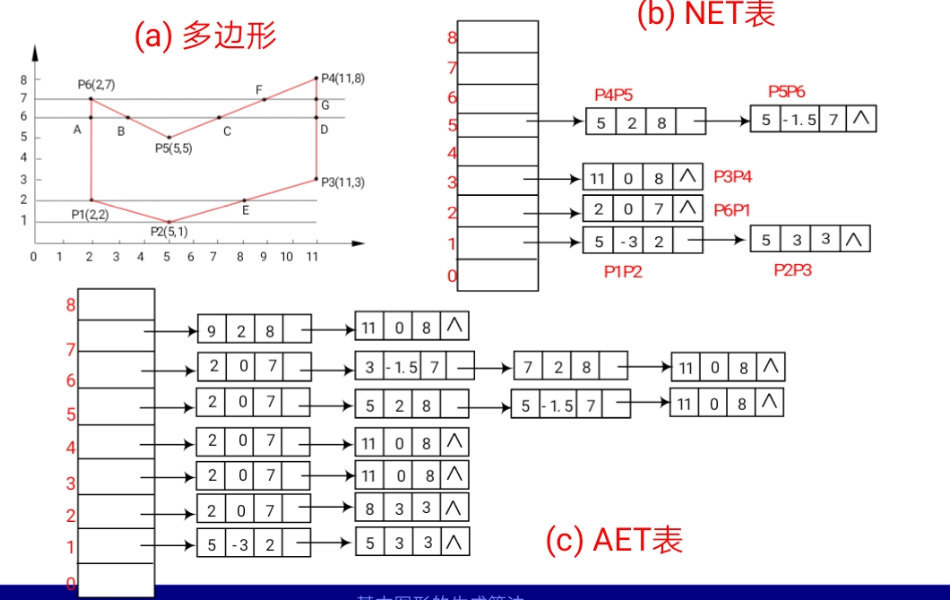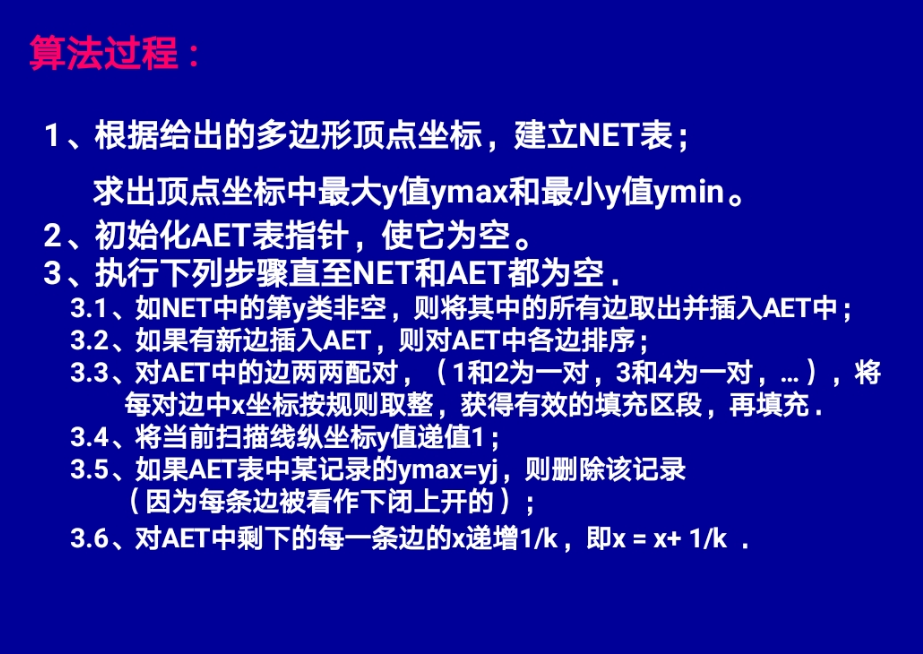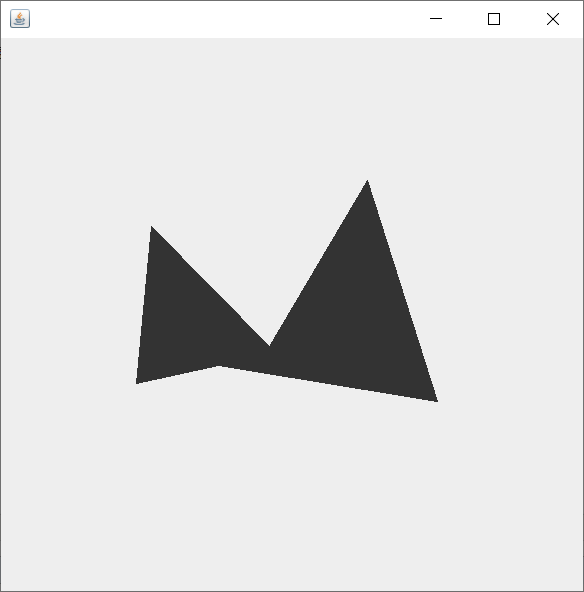JAVA实现扫描线算法
首先说一下,教科书上的扫描线算法确实是用c++很好实现,而且网上有很多源码,而java实现的基本没有(可能是我没看到),所以还是打算自己码(实验作业写这个而自己又个是写java的猿0.0)。
对于扫描线的实现过程,我只在这里大概讲下书本上的内容(自己去看),主要还是讲一下自己实现时算法的改动和实现方法。
扫描线算法:顾名思义,就是从Ymin开始扫描,然后构建出NET,之后根据NET建立AET。
贴个图:


实现的时候首先是构造NET,因为对于java来说不能像c++一样直接用指针所以我用对象数组和Node类(如下代码)构造了类似数组+指针的数据结构。在实现了NET后开始通过NET实现AET,在这里我改变了一种实现方式,教科书上是一次次遍历扫描线,然后将NET插入AET后进行排序等一系列操作,而我因为是自己写的数据结构,如果说再建个表按书上的方式来最后还得自己实现链表排序等一系列操作。所以我这里直接用一个包含Arraylist的对象数组代替了。我的方法是:直接从NET开始遍历每个节点,得到节点后将它以及它自己之后会引申出的插入AET的节点(比如当前扫描线y=0 节点 X:1 dx:-1 Ymax:3 那之后会插入AET的就是 0 -1 1 和 -1 -1 2 )将这些节点不论顺序的先插入AET对应扫描线位置的对象数组的list中,将NET中节点全部遍历完之后再最后对AET中每个对象数组的list进行排序。最后得到了NET在进行打印。
贴个代码(仅供参考学习交流):
package PolygonScanningAndFilling;
public class Node { //新编表记录x,dx,yMax
public int x;
public float dx;
public int yMax;
public Node next;
public int ymin;
public Node(int x, int dx, int yMax){
this.x=x;
this.dx=dx;
this.yMax=yMax;
}
public void getYmin(int Ymin){
this.ymin=Ymin;
}
}
package PolygonScanningAndFilling; import java.util.ArrayList;
import java.util.Collections;
import java.util.List; public class classAndArray { public List<Integer> list = new ArrayList<Integer>();
public classAndArray(){ }
public void listSort() {
Collections.sort(list);
}
}
package PolygonScanningAndFilling; import java.util.Iterator;
import java.util.Timer;
import java.util.TimerTask;
import javax.swing.*;
import java.awt.*;
import java.awt.event.ActionEvent;
import java.awt.event.ActionListener;
import java.awt.event.KeyEvent;
import java.awt.event.KeyListener;
import java.awt.event.MouseAdapter;
import java.awt.event.MouseEvent;
import java.io.IOException; public class PolygonScanning extends JPanel { static int X0;
static int Y0;
static int X1;
static int Y1;
static int a[]=new int [10]; //保存点击的10个x坐标
static int b[]=new int [10]; //保存点击的10个y坐标
static int index=0;
static int time=0;
static int time2=0;
static boolean add;
@Override
protected void paintComponent(Graphics g) {
super.paintComponent(g);
this.addMouseListener(new MouseAdapter() {
public void mouseExited(MouseEvent e) {
time++;
repaint(); }
public void mouseClicked(MouseEvent e) { if(e.getButton() == e.BUTTON1) {
add=true;
if(index!=0)
{
for(int i=0;i<index;i++)
{
if(a[i]==e.getX()&&b[i]==e.getY())
add=false;
}
}
if(add)
{ a[index]=e.getX();
b[index]=e.getY(); System.out.println("坐标为("+a[index]+","+b[index]+")");
index++; //frame.setVisible(true);
repaint();
System.out.print(time2);
if(time2==0)
time2++;
}
} // if(e.getButton() == e.BUTTON3)
// {
//
// }
} }); Graphics2D g2d = (Graphics2D)g;
int Ymax=0;
for(int i=0;i<b.length;i++)
{
if(Ymax<b[i])
Ymax=b[i];
}
// System.out.println("Ymax"+Ymax); /*
* 画出多边形
*/
if(time2>0)
{
System.out.print("开始");
int Sum=0;
for(;Sum<=index;Sum++) {
if(Sum==index-1)
{
g2d.drawLine(a[Sum], b[Sum], a[0],b[0]); break;
}
else
{
g2d.drawLine(a[Sum], b[Sum], a[Sum+1],b[Sum+1]); } }
} if(time!=0) { Node [] head =new Node [Ymax]; //建立对应扫描边数的链表长度
for(int i=0;i<index-1;i++)
{ if(b[i]<b[i+1]) //从第一个点开始若前一个点小于后一个点
{
if(head[b[i]]==null)
head[b[i]]=new Node(0,0,0);
head[b[i]].ymin=b[i]; if(head[b[i]].next==null) //该点是第一个插入的节点
{
head[b[i]].next=new Node(0,0,0);
head[b[i]].next.x=a[i];
head[b[i]].next.dx=(float)(a[i]-a[i+1])/(b[i]-b[i+1]);
head[b[i]].next.yMax=b[i+1]; //ymax为后一点的y
}
else { //该点不是第一个插入的节点
if(head[b[i]].next.next==null)
head[b[i]].next.next=new Node(0,0,0);
if((float)(a[i]-a[i+1])/(b[i]-b[i+1])<head[b[i]].next.dx) //当前插入x比之前存在的节点x小
{
head[b[i]].next.next.x=head[b[i]].next.x;
head[b[i]].next.next.dx=head[b[i]].next.dx;
head[b[i]].next.next.yMax=head[b[i]].next.yMax;
head[b[i]].next.x=a[i];
head[b[i]].next.dx=(float)(a[i]-a[i+1])/(b[i]-b[i+1]);
head[b[i]].next.yMax=b[i+1];
}
else
{
head[b[i]].next.next.x=a[i];
head[b[i]].next.next.dx=(float)(a[i]-a[i+1])/(b[i]-b[i+1]);
head[b[i]].next.next.yMax=b[i+1];
}
}
}
else
{
if(head[b[i+1]]==null)
head[b[i+1]]=new Node(0,0,0);
head[b[i+1]].ymin=b[i+1];
if(head[b[i+1]].next==null) //该点是第一个插入的节点
{
head[b[i+1]].next=new Node(0,0,0);
head[b[i+1]].next.x=a[i+1];
head[b[i+1]].next.dx=(float)(a[i]-a[i+1])/(b[i]-b[i+1]);
head[b[i+1]].next.yMax=b[i]; //ymax为后一点的y
}
else { //该点不是第一个插入的节点
if(head[b[i+1]].next.next==null)
head[b[i+1]].next.next=new Node(0,0,0);
if((float)(a[i]-a[i+1])/(b[i]-b[i+1])<head[b[i+1]].next.dx) //当前插入x比之前存在的节点x小
{
head[b[i+1]].next.next.x=head[b[i+1]].next.x;
head[b[i+1]].next.next.dx=(float)head[b[i+1]].next.dx;
head[b[i+1]].next.next.yMax=head[b[i+1]].next.yMax;
head[b[i+1]].next.x=a[i+1];
head[b[i+1]].next.dx=(float)(a[i]-a[i+1])/(b[i]-b[i+1]);
head[b[i+1]].next.yMax=b[i];
}
else
{
head[b[i+1]].next.next.x=a[i+1];
head[b[i+1]].next.next.dx=(float)(a[i]-a[i+1])/(b[i]-b[i+1]);
head[b[i+1]].next.next.yMax=b[i];
}
}
} }
if(index>0)
{ if(b[0]<b[index-1]) //从第一个点到最后一个点
{
if(head[b[0]]==null)
head[b[0]]=new Node(0,0,0);
head[b[0]].ymin=b[0]; if(head[b[0]].next==null) //该点是第一个插入的节点
{
head[b[0]].next=new Node(0,0,0);
head[b[0]].next.x=a[0];
head[b[0]].next.dx=(float)(a[0]-a[index-1])/(b[0]-b[index-1]);
head[b[0]].next.yMax=b[index-1]; //ymax为后一点的y
}
else { //该点不是第一个插入的节点
if(head[b[0]].next.next==null)
head[b[0]].next.next=new Node(0,0,0);
if((float)(a[0]-a[index-1])/(b[0]-b[index-1])<head[b[0]].next.dx) //当前插入x比之前存在的节点x小
{
head[b[0]].next.next.x=head[b[0]].next.x;
head[b[0]].next.next.dx=head[b[0]].next.dx;
head[b[0]].next.next.yMax=head[b[0]].next.yMax;
head[b[0]].next.x=a[0];
head[b[0]].next.dx=(float)(a[0]-a[index-1])/(b[0]-b[index-1]);
head[b[0]].next.yMax=b[index-1];
}
else
{
head[b[0]].next.next.x=a[0];
head[b[0]].next.next.dx=(float)(a[0]-a[index-1])/(b[0]-b[index-1]);
head[b[0]].next.next.yMax=b[index-1];
}
}
}
else
{
if(head[b[index-1]]==null)
head[b[index-1]]=new Node(0,0,0);
head[b[index-1]].ymin=b[index-1];
if(head[b[index-1]].next==null) //该点是第一个插入的节点
{
head[b[index-1]].next=new Node(0,0,0);
head[b[index-1]].next.x=a[index-1];
head[b[index-1]].next.dx=(float)(a[0]-a[index-1])/(b[0]-b[index-1]);
head[b[index-1]].next.yMax=b[0]; //ymax为后一点的y
}
else { //该点不是第一个插入的节点
if(head[b[index-1]].next.next==null)
head[b[index-1]].next.next=new Node(0,0,0);
if((float)(a[0]-a[index-1])/(b[0]-b[index-1])<head[b[index-1]].next.dx) //当前插入x比之前存在的节点x小
{
head[b[index-1]].next.next.x=head[b[index-1]].next.x;
head[b[index-1]].next.next.dx=head[b[index-1]].next.dx;
head[b[index-1]].next.next.yMax=head[b[index-1]].next.yMax;
head[b[index-1]].next.x=a[index-1];
head[b[index-1]].next.dx=(float)(a[0]-a[index-1])/(b[0]-b[index-1]);
head[b[index-1]].next.yMax=b[0];
}
else
{
head[b[index-1]].next.next.x=a[index-1];
head[b[index-1]].next.next.dx=(float)(a[0]-a[index-1])/(b[0]-b[index-1]);
head[b[index-1]].next.next.yMax=b[0];
}
}
}
} for(int i=0;i<Ymax;i++)
if(head[i]!=null)
while(head[i].next!=null)
{ System.out.println("新编表y"+head[i].ymin+"新编表x"+head[i].next.x+"新编表dx"+head[i].next.dx+"新编表yMax"+head[i].next.yMax);
if(head[i].next.next!=null)
{ System.out.println("多的"+"新编表y"+head[i].ymin+"新编表x"+head[i].next.next.x+"新编表dx"+head[i].next.next.dx+"新编表yMax"+head[i].next.next.yMax);
}
break;
}
int YMIN=b[0];
for(int i=0;i<b.length;i++)
{
if(YMIN>b[i]&&b[i]!=0)
YMIN=b[i]; } classAndArray [] ca=new classAndArray [Ymax];
for(int i=YMIN;i<Ymax;i++)
ca[i]=new classAndArray();
//一个点一个点的全装入ca中再排序打印出点
for(int i=0;i<Ymax;i++)
{
if(head[i]!=null)
if(head[i].next!=null)
{
//System.out.println("新编表y"+head[i].ymin+"新编表x"+head[i].next.x+"新编表dx"+head[i].next.dx+"新编表yMax"+head[i].next.yMax);
for(int j=head[i].ymin;j<head[i].next.yMax;j++)
{ ca[i+j-head[i].ymin].list.add(head[i].next.x+(int)(0.5+((j-head[i].ymin)*head[i].next.dx)));
//System.out.print("ca[i+j-head[i].ymin]为"+(i+j-head[i].ymin)+"值为"+ca[i+j-head[i].ymin].list.toString());
//System.out.println("Ymin为"+i+" x为"+(head[i].next.x+(j-head[i].ymin)*head[i].next.dx));
} if(head[i].next.next!=null)
{ for(int j=head[i].ymin;j<head[i].next.next.yMax;j++)
{ ca[i+j-head[i].ymin].list.add(head[i].next.next.x+(int)(0.5+(j-head[i].ymin)*head[i].next.next.dx));
//System.out.print("next中ca[i+j-head[i].ymin]为"+(i+j-head[i].ymin)+"值为"+ca[i+j-head[i].ymin].list.toString());
//System.out.println("Ymin为"+i+" x为"+head[i].next.next.x+(j-head[i].ymin)*head[i].next.next.dx);
}
//System.out.println("多的"+"新编表y"+head[i].ymin+"新编表x"+head[i].next.next.x+"新编表dx"+head[i].next.next.dx+"新编表yMax"+head[i].next.next.yMax);
} }
} //
for(int i=YMIN;i<Ymax;i++)
{
ca[i].listSort();
for (int j = 0; j < ca[i].list.size(); j++) {
if(j%2==0||(j==0))
{
g2d.drawLine(ca[i].list.get(j), i, ca[i].list.get(j+1), i);
}
}
System.out.println(ca[i].list.toString());
}
}
} private static void createAndShowGUI() {
JFrame frame = new JFrame(); frame.setLocationRelativeTo(null); frame.setLayout(null);
JPanel jp=new JPanel(); frame.setVisible(true); frame.setContentPane(new PolygonScanning()); frame.setSize(600, 600);
frame.setDefaultCloseOperation(JFrame.EXIT_ON_CLOSE);
frame.setLocationRelativeTo(null);
frame.setVisible(true);
} public static void main(String[] args) throws IOException { createAndShowGUI(); }
}
效果截图(先在面板里点击点,鼠标移出面板填充)


JAVA实现扫描线算法的更多相关文章
- Spark案例分析
一.需求:计算网页访问量前三名 import org.apache.spark.rdd.RDD import org.apache.spark.{SparkConf, SparkContext} /* ...
- hdu-1542 Atlantis(离散化+线段树+扫描线算法)
题目链接: Atlantis Time Limit: 2000/1000 MS (Java/Others) Memory Limit: 65536/32768 K (Java/Others) ...
- JAVA实现种子填充算法
种子填充算法原理在网上很多地方都能找到,这篇是继上篇扫描线算法后另一种填充算法,直接上实现代码啦0.0 我的实现只是实现了种子填充算法,但是运行效率不快,如果大佬有改进方法,欢迎和我交流,谢谢! 最后 ...
- 故障重现(内存篇2),JAVA内存不足导致频繁回收和swap引起的性能问题
背景起因: 记起以前的另一次也是关于内存的调优分享下 有个系统平时运行非常稳定运行(没经历过大并发考验),然而在一次活动后,人数并发一上来后,系统开始卡. 我按经验开始调优,在每个关键步骤的加入如 ...
- Elasticsearch之java的基本操作一
摘要 接触ElasticSearch已经有一段了.在这期间,遇到很多问题,但在最后自己的不断探索下解决了这些问题.看到网上或多或少的都有一些介绍ElasticSearch相关知识的文档,但个人觉得 ...
- 论:开发者信仰之“天下IT是一家“(Java .NET篇)
比尔盖茨公认的IT界领军人物,打造了辉煌一时的PC时代. 2008年,史蒂夫鲍尔默接替了盖茨的工作,成为微软公司的总裁. 2013年他与微软做了最后的道别. 2013年以后,我才真正看到了微软的变化. ...
- 故障重现, JAVA进程内存不够时突然挂掉模拟
背景,服务器上的一个JAVA服务进程突然挂掉,查看产生了崩溃日志,如下: # Set larger code cache with -XX:ReservedCodeCacheSize= # This ...
- 死磕内存篇 --- JAVA进程和linux内存间的大小关系
运行个JAVA 用sleep去hold住 package org.hjb.test; public class TestOnly { public static void main(String[] ...
- 【小程序分享篇 一 】开发了个JAVA小程序, 用于清除内存卡或者U盘里的垃圾文件非常有用
有一种场景, 手机内存卡空间被用光了,但又不知道哪个文件占用了太大,一个个文件夹去找又太麻烦,所以我开发了个小程序把手机所有文件(包括路径下所有层次子文件夹下的文件)进行一个排序,这样你就可以找出哪个 ...
随机推荐
- 在linux服务器上装svn版本管理,自动部署代码到web项目
在linux服务器上装svn版本管理,自动部署代码到项目 1.安装svn服务器端 yum install subversion 从镜像下载安装svn服务器端 中间会提示是否ok,输入y,确认 ...
- Maven 创建项目之简单示例
maven 是一个项目管理工具.可以用来管理jar包依赖,构建项目等. 那么接下来,就在eclipse中使用maven创建一个简单的项目. 1,依次点击File-> New -> Othe ...
- Transformer各层网络结构详解!面试必备!(附代码实现)
1. 什么是Transformer <Attention Is All You Need>是一篇Google提出的将Attention思想发挥到极致的论文.这篇论文中提出一个全新的模型,叫 ...
- jquery让form表单异步提交
1.监听表单提交事件,并阻止表单提交 $("form").submit(function(e) { return false;//阻止表单提交 }) 2.拿到表单内容 let da ...
- docker运行jexus+mono爬坑记
新的.net core都已经支持docker.手头有一些原来开发的asp.net旧项目,用的asp.net mvc开发的,跑在.net formwork 4.6上. 在docker的公共仓库searc ...
- intellij idea 2018 激活
http://idea.toocruel.net http://active.chinapyg.com/ 2018-8-6可用 http://xdouble.cn:8888/ 2018年7月11号 测 ...
- helm部署Filebeat + ELK
helm部署Filebeat + ELK 系统架构图: 1) 多个Filebeat在各个Node进行日志采集,然后上传至Logstash 2) 多个Logstash节点并行(负载均衡,不作为集群),对 ...
- phaser学习总结之Text对象详解
前言 在phaser学习总结之phaser入门教程中,我们已经入门了phaser,对phaser也有所了解但是我们并没有对phaser中的每个对象的属性和方法进行详解,本章将对phaser中的Text ...
- python import cv2异常(dll load fail / windows server 2008)
最近服务器迁移,从得win7系统迁移到云服务器器上的windows server2008系统,迁移过程中安装Python的opencv一直出错,不管是用whl安装或者是在线pip安装都报错,尝试打包成 ...
- 理解 Redux 的中间件
将该思想抽象出来,其实和 Redux 就无关了.问题变成,怎样实现在截获函数的执行,以在其执行前后添加自己的逻辑. 为了演示,我们准备如下的示例代码来模拟 Redux dispatch action ...
